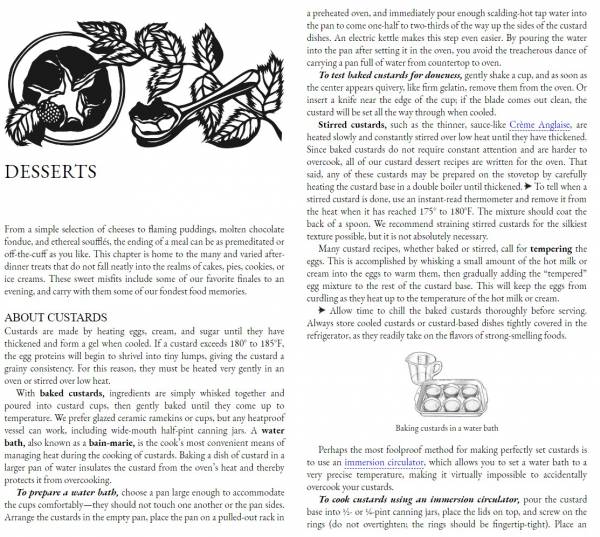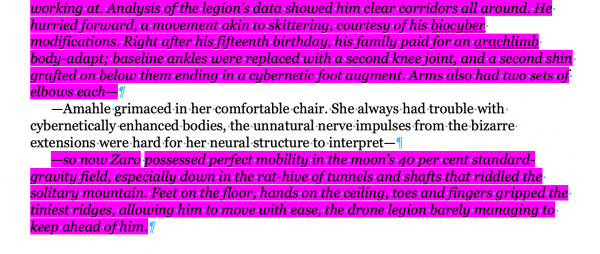Table of Contents
Bold, italics, underline, and strikethrough
These types of formatting can cause accessibility barriers to people with print disabilities. We have to be careful when we retain this type of formatting.
When we do keep Bold or Italics we use the Styles, and not direct formatting (via the toolbar).
Emphasis style(italics) - this translates to the <em> tag in XMLStrong style(bold) - translates to the <strong> tag in XML
If we need to use strikethrough or underline, this will be one of the rare occasions when we use direct formatting.
Italics
Italicized text can create accessibility barriers for a lot of users who find it difficult to read. Blocks or paragraphs of italicized text are particularly problematic, and italics should be removed from these sorts of sections. In general, italics (or the <em> tag) should be removed unless they are used to convey important meaning, like if the text needs to be vocally stressed, or a change of voice, or tone like a thought, or dream sequence, or a similar divergence from the main narrative. Stage directions (in plays) are another case where we’d use the Emphasis Style. Whenever there is what they call a “semantic significance” behind the emphasis then it would usually be appropriate to retain it.
Remove Italics from:
- paragraphs or blocks of text
- Full sentences and long phrases (unless a thought or dream sequence.)
- titles (books, movies, etc.)
Leave Italics in place when:
- they are used to convey important meaning:
- In the sentence “I never said she stole my money.” Depending on which one of the seven words you emphasize, the sentence can have seven different meanings!
- Poetry (ask Production Coordinator)
- Thoughts
- Dream Sequences
Example 1:
"I never said she stole my money."
"I never said she stole my money."
"I never said she stole my money."
and so on.
Example 2:
Emphasis and italics seem to be kinda confusing. Thought the Production Assistant. I am not sure if I should use them in the particular case. I am gonna email the Production Coordinator.
Example 3:
Stage direction example.
Exit, pursued by bear.
Quote. See the section on Block Quotations for more information.
The current workflow as follows:
- Download the word doc from cyberduck and save as working file (Title_of_Book_YourLastName). This is the one you will be reformatting
- Download the word doc again, you can rename it if you wish or leave its original name. This is the untouched version. The point is to have one copy to reformat, and one to keep intact
- Keep both open at same time
- Use advanced search in original to locate italics/emphasis:
- Search for italics by opening Advanced Find and Replace, Go to Format, choose Font and Select Italics. Here is a video demo on Searching for Italics
- Search for Emphasis by opening Advanced Find and Replace, Go to Format, choose Style, and select Emphasis. Here is a video demo on Searching for Emphasis
- Use search to find word/phrase in working copy to apply emphasis style
This should help speed up the process of locating the emphasis in the original.
Bold
Remove bold from the text unless it conveys important meaning, such as poetry.
Bold text (or the <strong> tag) should be used to indicate importance, such as when making imperative statements or using signal words like 'warning' and 'alert'.
It can also be used for character names in plays. See the section on Plays for more information.
Underline
Underlined text should be removed from the text unless deemed necessary. Underlines often present an accessibility barrier for users and people often confuse the text for links. If underlined text needs to be retained (e.g., in a poem where it conveys important meaning), use direct formatting.
Strikethrough
Replace Strikethrough with a square bracket note that contains the strikethough text and the phrase struck out.
For example: My [worst struck out] best Christmas ever.
Another example is in the image below of a letter found in a book written by one of the characters. The character has struck out their first attempt at a salutation. When reformatting this in Word, replace the struck through text with the following: [Your Friend Always struck out]
Q&A Archive
Q: In Butter Honey Pig Bread, there are a number of emails and letters utilized as part of the narrative. In the ebook, the letters are formatted with italics, however the emails do not have any distinct formatting.What is the best approach to reformatting these sections. Should I apply quote style or leave without formatting?
A: You can apply quote format to these sections.
Q: In Joy of Cooking, some sections include methods of cooking which are formatted as shown in this image:
With the beginning of the sentence describing the method bolded and italicized (To prepare a water bath; to test baked custards for doneness; to cook custards using an immersion circulator). Should these be formatted in any special way?
A: You can remove the styling from those phrases as they styling is just for visual purposes and adds not additional meaning to the text. When someone reads the text, they will understand what it is saying without the extra styles. We want to avoid using bold and emphasis where ever possible as it can create accessibility errors.
Q: In the book "What the Bible is All About", there is a sort of mnemonic that I'm unsure how to format. It's in chapter 45 on page 508 when I view it in Adobe Digital Editions. It displays as follows:
Forsaking
All
I
Take
Him
So, it looks like a list but isn't really a list. And it has the first letter of each word bolded to show that they spell "Faith". For now, I have left it with each word on a separate line but not as a list and I applied Strong style to the first letter of each word to mimic how it appears in the book. Do you think there's a better way to handle it?
A: The way you handled this is correct. You don't have to format this as a list, and keep the first letter in strong style. Good work!
Q: One more question regarding There be Pirates. This is juvenile non-fiction book that utilizes a glossary to define unfamiliar vocabulary. Through out the text, these vocabulary words are highlighted in bold to indicate they can be found in the glossary. Would it be best to leave these words without formatting, or use emphasis?
A: You can leave it as bold style.
Q: Light Chaser has several sections where large blocks of text are in italic to indicate when the main character is exploring the memories of a cybernetic body (or something like that). Sometimes the text goes back and forth between italic and normal to show the character moving through the memories versus having thoughts about them in the present. Here's a screenshot of what the original word doc looks like (italics highlighted):
I have NOT been adding emphasis to any of these large blocks of text given italics isn't accessible in text blocks of that size. Do we feel the m-dashes breaking up the text blocks do enough to indicate the character slipping in and out of the cybernetic memory?
A: I think you have the right approach here. The paragraph breaks and m dashes are enough. We can only work with what we have. Good work!
Q: Should text messages/"Facebook posts"/etcetera be styled with emphasis if they are italicized in the original text? Do these operate as thoughts? Specifically, I'm editing A Dream of a Woman and there are a lot of text message exchanges like this:
Buzz in his bag. Probably her. He sat on a bench, pulled on his hair, opened his phone guiltily, and it was Iris: Hey sweetiepants! I’m drunk near your restaurant, whatcha doing? The feeling of sweat and grossness flickered brighter exactly once in his body. Then he called her.
A: To answer your question: it would depend on the book and the usage. Remember emphasis is not very accessible overall, so we want to avoid it as much as possible. I looked over the first few pages on the book and this is what I noticed:
- Each new section begins with italics (this is created for visual style and it loses no meaning when you remove it, so we remove it.)
- Thoughts we keep and style as emphasis because the emphasis adds meaning to the text
- Do not use it for facebook messages (it is clear from the text what they are so it is more for visual impact than meaning, so we do no use it.)
- There are moments she is reading a sign and it is in italics and again it is clear from the text what this is so we do not use it.
In the example you give above, it is a bit of a judgement call. The emphasis does seem to be adding meaning to the text in this case, and it is only one sentence. If it was more than 2-3 or was a paragraph it should be removed, but it is one sentence. We need to ask ourselves: if we remove the emphasis/italics can the meaning of the text still be understood by the reader? In this specific example I am leaning more towards no, so it can be kept.
Note: there are always some exceptions to these guidelines, so whenever in doubt ask!
Q: I have a question about Inkling. When the Inkling character speaks, the text is bold and all caps (no quotation marks). Obviously not accessible. Is there another way I should designate this as dialogue (emphasis style?)or should I just leave it as normal text? Thanks!
A: First off, I now want to read this book. In this case you can remove the All Caps and use Sentence Capitalization and apply strong style.
Q: I'm working on Orange Shirt Day and have a few questions. In the text are bolded vocabulary terms which refer to the glossary (Chapter 9). Additionally, the vocabulary terms are also at the bottom of the page they are found on. The text specifies: "Terms that require a definition will be shown in bold font. For these terms, there will be a definition provided at the bottom of the text and/or in the back of the book in the glossary." Regarding the vocabulary terms, should I apply strong style? Regarding the terms and definitions at the bottom of the pages, should I leave them as part of the natural flow of text or treat them as an aside? Thanks!

A: For this title, you can apply strong style to the bolded letters since the text directly states all glossary terms are in bold. You can treat those other sections as asides. It looks like they used space and slightly smaller font to visually separate the text on the page.
Q: Another question for "Angel Wing Splash Pattern," in the story "How I saved Christmas" the author uses lists that have bold and underlined titles. I know we are not supposed to use bold and underline formatting except when it conveys important information, such as poetry, so I am wondering if it would be appropriate to format these as nested lists, with the title at level 1 and the listed items at level 2? See example:
 Edit: I am now thinking it may be best to format the list titles as sub-headings and I am wondering if there would be issues with accessibility if there are two non-consecutive sub-headings that have the same wording, i.e. two sub-headings titled "Things to do today"?
Edit: I am now thinking it may be best to format the list titles as sub-headings and I am wondering if there would be issues with accessibility if there are two non-consecutive sub-headings that have the same wording, i.e. two sub-headings titled "Things to do today"?
A: This answer is linked to the below edit as well. All the bold underline text should be styled a sub headings. If the content in that subsection is a list, style as a list. If it is not a list, style as normal.
Q: One more question for "Angel Wing Splash Pattern," in the story "How I saved Christmas" the text includes some short poems with bolded and underlined titles, e.g. Vidoe Games and Pornos. Should the bold and underline formatting be removed and normal style applied to all three lines of the poem?
Edit: As I'm working through the story there seems to be a number of other sections that are mostly prose that also use bold and underlined titles for and I'm thinking it might be appropriate to format all the titles as sub-headings.

A: Titles of poems are styled as headings. See Poetry for more info.
Q: The story "Goodmind" in "Before the Usual Time" uses lots of italics. In some cases it is implied that it is the main character's thoughts, though it is not explicitly stated. Would I still apply the emphasis style? The story also uses italics to denote messages that the main character receives through an online chat platform. Would that run along the same lines as thoughts (in which case we would keep the emphasis style) or should I change those to normal formatting?
A: Thoughts retain emphasis, remove from chat messages. When you read the text all the messages seem to begin with referring to the message directly followed by a colon. This means that the reader can understand that the following text is a chat message without the emphasis, and that it is only used to add visual meaning and is therefore not required.
Q: In a couple of the short stories in the collection "Before the Usual Time" capitalization is used for emphasis (ex. "What if I could GUARANTEE you'll see your work last until the seventh generation?"). The wiki says we keep emphasis and capitalization for stylistic choices and when it adds meaning, which I would say this is. However in this case would it be better to keep it in all capitals as in the original, or would it be better to use strong or emphasis style as readers might read capitals out letter by letter?
A: In this case you can replace it with emphasis, but in future cases if you are unsure then ask.
Q: In How to Lose Everything there is the line "Maybe I am dying". The original is in italics because it is a thought of the author in the moment, italicized to differentiate the thought from the rest of the text, but the "am" is in regular font to create emphasis within the thought sentence. Would it be best to just apply emphasis style to the italicized parts "Maybe I" and "dying" and leave "am" as normal/no style to indicate the emphasis within emphasis, or should I just apply emphasis style to the entire phrase?
A: Style it they way it is in the original.



